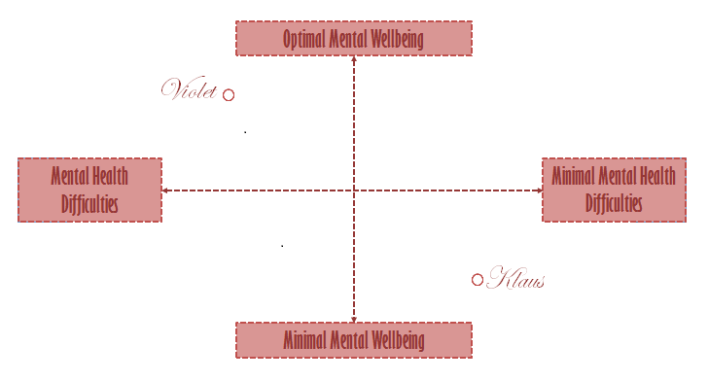
Within the UK, 29% of university students experience clinical levels of psychological distress and NUS surveys reveal that 78% experience difficulties with mental health. Despite this, only 15 out of every 1000 students disclose these difficulties to their institution. For University Mental Health Day I attended a workshop that focused on identifying and addressing these difficulties in student groups. And the first objective was to help them distinguish between mental health difficulties and mental wellbeing.
These two terms aren’t interchangeable and the ideal way to differentiate between them is to draw examples with physical equivalents. An individual can suffer from a disease, which would be termed a physical health difficulty. Or an individual can be disease free but may not be exercising or eating enough, which can be dehabilitating to the wellbeing of their body. This metaphor follows true for our minds as well.
Mental health difficulties refer to the conditions and disorders that are diagnosed in individuals by experts, dependent on symptoms and criteria. Psychosis, catatonia and insomnia are just some of the mental health difficulties an individual can suffer from. Mental wellbeing refers to an individual’s mental health independent of a disorder. How you’re feeling, how well you’re coping, what you’re doing to keep calm, happy or clear headed, your behaviour and habits, all factor into mental wellbeing.
What often happens, especially within younger groups, is a misunderstanding of these two concepts. Experiencing poor mental wellbeing, such as overwhelming stress or sadness, can be mistaken for a disorder, such as anxiety or depression. The truth is, not everyone will be diagnosed with a mental health difficulty but everyone can sometimes face issues regarding their mental wellbeing.
 From the graph above we can see that mental health difficulties and mental wellbeing are continuums, because it’s not just a matter of the presence or absence of a problem. The severity of mental health difficulties and wellbeing can range anywhere from high to low, minimal to optimal, and together determine where anyone falls on the graph. And in this way, both continuums coexist. How is this possible?
From the graph above we can see that mental health difficulties and mental wellbeing are continuums, because it’s not just a matter of the presence or absence of a problem. The severity of mental health difficulties and wellbeing can range anywhere from high to low, minimal to optimal, and together determine where anyone falls on the graph. And in this way, both continuums coexist. How is this possible?

Let’s look at Violet*, in the upper left hand area of the graph, high on the mental wellbeing continuum but low on the mental health difficulties one. How can we interpret this? Let’s say Violet has been diagnosed with agoraphobia – a fear of open or public spaces. But through regular sessions with her psychologist, an established routine and regular intake of her medication she is managing her phobia and functioning in society. Thus, Violet demonstrates mental health difficulties but optimal mental wellbeing – despite the problem, she’s looking after herself.

Then there’s Klaus, in the bottom right hand area of the graph, high on the mental health difficulties continuum but not so good on the wellbeing one. Klaus has no mental health difficulties but financial pressures have forced him to take on extra shifts, increasing his workload, resulting in long periods of stress and isolation. Klaus, though having no mental health difficulties, is exhibiting minimal mental wellbeing.
Furthermore, the relationship between both continuums can result in one effecting the other; instances of high mental wellbeing can improve mental health difficulties. We can imagine such might be the case with Violet, who may eventually be cured of her phobia due to her conscientious behaviour. In less optimistic situations we may also find that mental health difficulties lead to an individual’s reduced mental wellbeing. And in the case of Klaus, poor mental wellbeing can lead to developing a mental health difficulty- if Klaus continues to undergo a state of all work and no play he could be in danger of developing depression.
Therefore, we can understand how our overall mental state fluctuates on these continuums and how reliant they are on one another, thus needing to be attended to regularly- we should be aiming for the upper right hand area of the graph.
Now, whether or not we develop a mental health difficulty isn’t really a choice, just as contracting a disease or being diagnosed with a condition isn’t a choice. But, just as we can choose to engage in habits that are fulfilling for our bodily wellbeing, we can choose to engage in habits beneficial for our mental wellbeing and this bumps up our odds of avoiding, or at least coping with, mental health difficulties. Think of it this way – cancer doesn’t discriminate between patients but you are at higher risk of being diagnosed with it if you smoke.
Therefore, with a thorough understanding of the difference between mental health difficulties and mental wellbeing, individuals can distinguish between what is and isn’t in their control and learn to focus on what is. Being aware of your mental state can also help decide what resources would be appropriate to access if necessary and how to convey what you, and understand what others, might be going through.
I’ll be exploring this further along with spotting signs of mental health struggle and communication techniques in my upcoming posts!
*I do not apologise for my A Series of Unfortunate Events references

I think another issue that adds to the problem is the tendency of young people to self diagnose. People readily google and label themselves with mental disorders without consideration of other factors.
LikeLiked by 1 person
That’s very true. While it’s great that teens know more about mental disorders I think they still lack the knowledge to identify disorders within themselves. Which leads back to the whole being able to differentiate between having a disorder and having poor mental wellbeing.
LikeLike
Exactly, knowing more about mental illness can help many teens go seek help and get better but the disturbing trend I’ve noticed is that teens diagnose themselves with a disorder and view it as if it’s some unique fashion accessory. I’m sure if you pointed this out to someone who does this they would diagnose themselves with hypochondriasis.
LikeLiked by 1 person